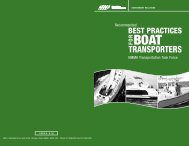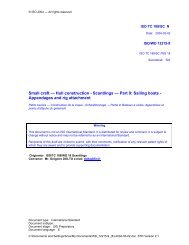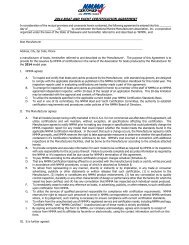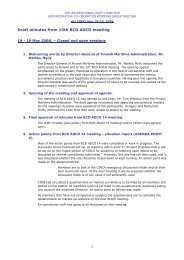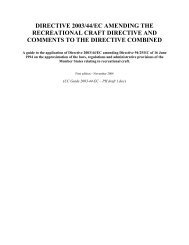global environmental legislation guide - National Marine ...
global environmental legislation guide - National Marine ...
global environmental legislation guide - National Marine ...
Create successful ePaper yourself
Turn your PDF publications into a flip-book with our unique Google optimized e-Paper software.
ook; and/or sample the ballast water. If there are concerns, a detailed inspection may becarried out. The party carrying out the inspection shall ensure that the ship does notdischarge ballast water until it can do so without presenting a threat of harm to theenvironment, human health, property or recourses.The convention came in force in 2005, and the new BMW Convention will come in force in2012.Issues for the recreational marine and superyacht industriesRecreational crafts are generally exempt through the principles of “equivalent compliance”but the flag state authority must agree to this. The principle of equivalent compliance can beapplied on “pleasure crafts used solely for recreation or competition (…) less than 50 metersin overall length and with a maximum ballast water capacity of eight cubic meters”. Yachts incommercial use, yachts exceeding a maximum length of 50m or exceeding a ballast watercapacity of 8m, 3 have to fully comply with the BWM convention.C. The international convention on control of harmful anti-fouling Systems on ships(IMO AFS Convention)The convention will prohibit the use of harmful substances in anti-fouling paints used onships and establish a mechanism to prevent the potential future use of other harmfulsubstances in anti-fouling systems. Under the terms of the new convention, parties of theconvention are required to prohibit and/or restrict the use of harmful anti-fouling systemson ships by flying their flag, as well as ships not entitled to fly their flag but which operateunder their authority and all ships that enter a port, shipyard or offshore terminal of a party.Ships of 400 gross tonnage and above engaged in international voyages (excluding fixed orfloating platforms, FSUs and FPSOs) will be required to undergo an initial survey before theship is put into service or before the international anti-fouling system certificate is issued forthe first time and a survey when the anti-fouling systems are changed or replaced. Ships of24 metres or more in length, but less than 400 gross tonnage, engaged in internationalvoyages (excluding fixed or floating platforms, FSUs and FPSOs) will have to carry adeclaration on anti-fouling systems signed by the owner or authorized agent. Thedeclaration will have to be accompanied by appropriate documentation such as a paintreceipt or contractor invoice.In 1990, IMO’s <strong>Marine</strong> Environment Protection Committee (MEPC) adopted a resolutionwhich advised governments to adopt measures to eliminate the use of anti-fouling paintcontaining TBT on vessels of less than 25 metres in length. In November 1999, IMO adoptedan assembly resolution that called for the MEPC to develop an instrument, legally bindingthroughout the world, to address the harmful effects of anti-fouling systems used on ships.The resolution called for a <strong>global</strong> prohibition on the application of organotin compoundswhich act as biocides in anti-fouling systems on ships by 1 January 2003, and a completeprohibition by 1 January 2008.D. IMO Guidelines to minimize bio foulingMember states of the International Maritime Organization (IMO) made a clear commitmentto minimizing the transfer of invasive aquatic species by shipping. Studies have shown that34



